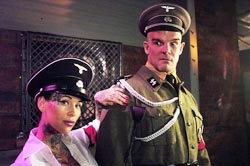
 Law of diminishing returns be damned, the accidental franchise that began with 2001’s The Fast and the Furious not only keeps chugging along well past other repeat players’ sell-by dates, but somehow grows even more successful. Now we’re up to Furious 7. Seven!
Law of diminishing returns be damned, the accidental franchise that began with 2001’s The Fast and the Furious not only keeps chugging along well past other repeat players’ sell-by dates, but somehow grows even more successful. Now we’re up to Furious 7. Seven!
In terms of sequentially numbered series — no reboots, no remakes — such longevity and mobility are unheard of. For sake of perspective, other chapter sevens have found Friday the 13th’s Jason Voorhees facing New Blood in the form of a telekinetic teenager, and the Police Academy gang on a rather говенный Mission to Moscow. Respect, Furious 7, respect.
After the one-two horror punch of Insidious and The Conjuring, director James Wan trades poltergeists for pistons to take over the driver’s seat from Justin Lin, helmer of the past four adventures, from 2006’s underrated Tokyo Drift to 2013’s Fast & Furious 6. The change is imperceptible, because Wan keeps the camera at ass-cheek level around the gyrating bikini models and follows the Mad Libs plot structure: Reformed ex-con Dominic Toretto (Vin Diesel, Riddick) is called upon to reassemble his team of gearheads for one last time — again!
 For this go-round, the whole frickin’ world is at stake, with terrorists itching to wrest control of a global-surveillance system by kidnapping a frizzy-haired hacker (Nathalie Emmanuel, TV’s Game of Thrones) who conveniently looks dynamite in a bikini. And who else does the U.S. government rely upon to quash the threat but a bunch of grease monkeys with an extended subscription to Motor Trend … but only for the pictures.
For this go-round, the whole frickin’ world is at stake, with terrorists itching to wrest control of a global-surveillance system by kidnapping a frizzy-haired hacker (Nathalie Emmanuel, TV’s Game of Thrones) who conveniently looks dynamite in a bikini. And who else does the U.S. government rely upon to quash the threat but a bunch of grease monkeys with an extended subscription to Motor Trend … but only for the pictures.
So stuffed to the brim is F7 that it juggles two villains: the aforementioned international terrorist (Djimon Hounsou, Guardians of the Galaxy) and a British special-ops assassin (Jason Statham, The Expendables 3) who’s hissing-snake evil in his quest for vengeance following the murder of his F6-antagonist brother. As for the movie’s three set pieces, “big” doesn’t do them justice. They’re so outrageous — and know it — that they remind one of elementary schoolers tearing up Mom’s garden by playing with Hot Wheels: Cars parachute from military aircraft! Cars fly from skyscraper to skyscraper! Cars leap hovering helicopters! Whatever they dream up has been rendered possible and sold as plausible.
Not wanting to mess with a good thing — assuming you found the past couple of sequels to be that (and I did) — F7 retains that fizzy feeling for more than two hours, with Wan turning in what amounts to an all-star edition that presents practically every not-dead character from previous installments as audience rewards, complete with intentionally howl-worthy dialogue. The studio juggernaut feels like a love letter — or a “swipe right” on Tinder — to those long-haul fans who, like Dom, aim to live their lives a quarter-mile at a time. (That it marks the final bow for co-star Paul Walker, who died tragically halfway through filming, makes those good vibes stickier.)
New to the fold on sides both heroic and hateful are a smooth-as-snot Kurt Russell (Grindhouse); Ong-Bak’s Tony Jaa, Thailand’s answer to Jackie Chan; and UFC champ Ronda Rousey. Among the most notable returners is Diesel’s belly button, which, jutting from beneath a muscle shirt in the fiery climax, resembles a rather intimidating camel toe. —Rod Lott

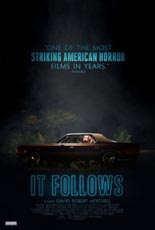
 So much of modern horror has been reduced to a series of cheap jumps and contrived shock-value tactics, a trend 20 years or so in the making that managed to suck a lot of the life out of a once artful ilk. The genre arguably peaked in the late ’70s and early ’80s with heavily stylized, blood-curling flicks like Dario Argento’s
So much of modern horror has been reduced to a series of cheap jumps and contrived shock-value tactics, a trend 20 years or so in the making that managed to suck a lot of the life out of a once artful ilk. The genre arguably peaked in the late ’70s and early ’80s with heavily stylized, blood-curling flicks like Dario Argento’s 

 Hypothetical question: It’s the year 1996, and alien beings, cleverly disguised as humans, are destroying the earth for their own selfish needs. Who you gonna call? No, not Rowdy Roddy Piper; he sacrificed himself a few years back (that’s a
Hypothetical question: It’s the year 1996, and alien beings, cleverly disguised as humans, are destroying the earth for their own selfish needs. Who you gonna call? No, not Rowdy Roddy Piper; he sacrificed himself a few years back (that’s a 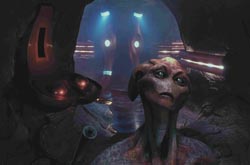
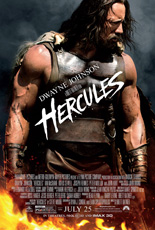
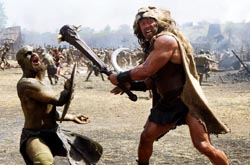
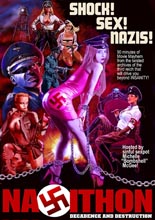
 Following close on the stiletto heels of 2013’s
Following close on the stiletto heels of 2013’s 